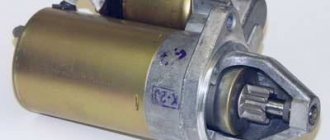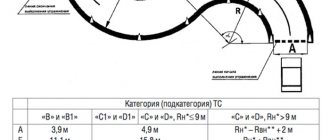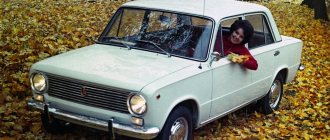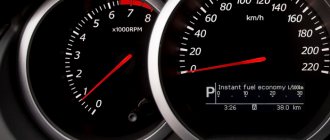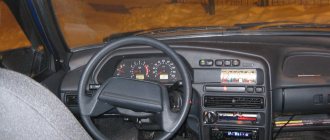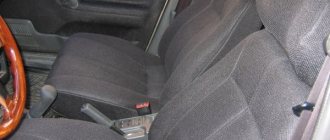Author: Lan, don’t growl
May 29, 2022 11:58
Tags: 2101 Fiat vases
30736
20
Among the eternal questions “what comes first, the egg or the chicken?”, “what is truth?” and “when will the Russian national football team win anything?” The purely automotive dilemma also occupies a worthy place. What did Soviet designers do with the FIAT-124, turning it into a Zhiguli? Spoiled or improved?
0
Source:
See all photos in the gallery
I recently came across an interesting article from the Hungarian magazine Oldtimer & Youngtimer, dedicated to comparing the Lada 1200 and FIAT 124. I found the material quite interesting, I hope you will like it too.
0
Source:
“So, FIAT conceived the 124 sedan in the first half of the 60s, presented it to the public in 1966, and received the title of “European Car of the Year 1967” for it. Judging by reports from the automotive press at the time, it was a good car. True, it’s a little old-fashioned, given the engine with pushrod valve drive, rear dependent suspension, worm-type steering and three-volume body. In the late 60s, the USSR government was in search of an ideal candidate for the title of the country's main people's car, which would be cheaper to produce and more durable than the Moskvich-408. More than a dozen foreign-made models were tested, but in the end the choice fell on the FIAT 124, which was destined to turn into a Zhiguli. According to the signed agreement, the Soviet side had the right to make changes to the FIAT design in order to adapt the car to the climatic and road conditions of the country. A lot has changed: from the suspension and engine to door handles and interior trim.
×
0
Source:
The production of the VAZ-2101 “Zhiguli” or Lada 1200 in the export name began in 1970 and over time, a sufficient number of Soviet “Fiats” ended up in the countries of the socialist bloc, including Hungary. However, even earlier, “original” copies of the FIAT 124 also made their way into Hungary, albeit not in such large quantities. I remember them well from childhood memories. Then we called them “strange Ladas” because of their unusual (compared to the Lada) bumpers and old-fashioned door handles. Personally, I liked the “Fiats” precisely from an ideological point of view. If, looking at the Lada, the image of an activist of the Komsomol movement appeared in my head against my will, then a passing FIAT awakened memories of films with the participation of Bud Spencer and Nina Lollobrigida. Those who drove Fiats noted that native Italian engines prefer high speeds and have more tenacious brakes. As we now know, all the main components and elements of the Lada were produced in the Soviet Union, and not in Italy, despite the fact that FIAT stamps can be found on some parts.
Hood and engine compartment of FIAT (left) and Lada. Pay attention to the design of the hood reinforcements
0
Source:
In any case, let's leave bygones to the past and turn to what we have, namely two beautiful cars that can be studied in detail. One of them is a “Zhiguli-1200” produced in 1971 - early “frets” can be distinguished by the crescent-shaped chrome trim on the headlights. The second car is much more rare: it is one of the first 124 Fiats assembled back in 1966. Both cars are from the private collection of Attila Vukmann, a famous Zhiguli fan in Hungary. In fact, I have been waiting for such a comparison for forty years, ever since I realized that the Russian and Italian versions of the car are not the same thing. It was 40 years of speculation, controversy and doubt. Is the original 124 with a more “fragile” suspension, a structurally outdated engine, but more efficient brakes really better than the more durable Russian counterpart? I remember a long time ago, the owners of Fiats claimed that they accelerated to 170 km/h. However, the first Lada also promised a top speed of 165 km/h... However, European buyers valued the steering and brakes in Fiats above all.
0
Source:
It must be admitted that by the end of the 70s in Europe no one was driving a FIAT 124, while Ladas continued to be exported in the 80s. Moreover, later versions differed from the earlier “Lada” not for the better: weak brakes, weak engines, a very “heavy” steering wheel. Perhaps a comparison of two early examples will show (or refute) the theory that initially the Ladas were at least in no way inferior to the Fiats? In theory, an overhead motor is more torquey than an engine with valves driven by pushrods. However, the FIAT push-rod destroys this stereotype. Even despite the imperfectly tuned carburetor, the 124 picks up speed much more readily. But the undoubted advantage of the Lada is its significantly larger traction reserve in the low operating range. The slightly more sporty character of the Italian is confirmed by the richer baritone of the exhaust system.
Movie about love
As you know, Soviet cinema professed only one direction - realism, therefore on the screen "Zhiguli" was also an indicator of the status of a movie hero. In the multi-part series “Guest from the Future,” space pirates Krys and Veselchak used a car of this brand to seduce the pioneer Kolya Gerasimov, who was hanging upside down, in order to extract the necessary information from him: “Well, do you want a Zhiguli?” Can you imagine, so small, and already a Zhiguli!”
The series was filmed in 1984, when the “penny” had been on the production line for almost a decade and a half. But she still remained the best. In the film “Winter Cherry,” filmed a year later, the “penny” of a Soviet research institute employee effectively caught up with a Mercedes-Benz W123 with a foreign company behind the wheel.
The most trump roles in films, of course, went not to the “penny”, but to luxury models: in the comedy “The Incredible Adventures of Italians in Russia”, the Italian actress Antonia Santilli performed risky stunts behind the wheel of a red “three ruble”... and three men in a Moskvich, of course couldn't keep up with her.
The outside mirror on early Zhiguli cars looked like this
0
Source:
Now let's take a look at some technical solutions. And here there are more differences than you can imagine! From the outside, only the massive fangs of the front bumper, hidden door handles, slightly increased ground clearance and the emblem with a rook on the radiator grille allow us to distinguish the Zhiguli from the FIAT. But this is only at first glance. Other “little things” will not escape a careful glance. For example, chrome caps with FIAT stamping (the same on Zhiguli cars, but without stamping) or an outside rear view mirror, which is on the Lada, but is not provided in the basic configuration of the Italian sedan. The mirror installed on Attila Vukmann's FIAT is from the factory accessories catalogue.
Information about Fiat 124
According to generally accepted information, Fiat-124 is the general name of a whole family of passenger cars that were produced by the company of the same name from Italy from 1966 to 1982.
Main technical characteristics of this vehicle:
- Engine – in-line, four-cylinder.
- Transmission - four-speed, mechanical type.
- The body layout is front-engine with rear-wheel drive.
- Weight and dimensions:
- length – 4042 mm;
- width – 1625 mm;
- height – 1420 mm;
- wheelbase – 2420 mm;
- weight – 855-950 kg.
...and on Lada. Take a lighter and heat it up))
0
Source:
Inside, the subtle differences continue. Russian and Italian cars have different latches for open doors, as well as designs for locking the triangular windows of the front doors. On a FIAT, the lock is installed on the metal frame of the window, while on a Zhiguli it is simply glued to the glass. At one time, the easiest way to steal a Lada (or at least get into the interior) was to melt the glue of the lock with a lighter. You can also note the much thicker floor mats in the Lada and the ability to fold down the backs of the front seats - you won’t be able to sleep on a FIAT. And, of course, the interior color scheme. If the interior of the Italian car is made mainly in brown tones, and the dashboard is generally gray (a great rarity, found on the early 124s), then Soviet designers gave preference to classically strict black.
What is better - “Kopeyka” or FIAT 124? (20 photos)
The 124's engine seems tiny in the engine compartment...
The Lada's overhead engine is more solid in appearance. By the way, it was also developed by Italians and was intended for the FIAT off-road model that never went into production
Controllability? I definitely liked the FIAT more. The car handles road unevenness better and rolls noticeably less when cornering. But - what a surprise! — the Italian’s brakes are frankly worse, despite the disc mechanisms at the front and rear. In fact, there is no need to be surprised: in the 60s, drum brakes were not much inferior in deceleration efficiency to disc brakes. The advantage of the discs was solely in their less tendency to overheat and to lock the wheels when the pedal is pressed sharply. Let's not forget, even if neither of the two cars has a vacuum servo brake booster (on Zhiguli it will appear later, and for Fiats the vacuum was available in more powerful models), at least the Russian car has a dual-circuit braking system . It's safer that way.
The same? Almost…
What both liked without question: the clarity of the gearbox shifts. Short lever strokes, pleasant sensations. But if the process of changing gears itself can be a pleasure, then the selection of gear ratios is disappointing: the gears are too short. According to factory data, both cars can easily reach 140 km/h or more. In fact, after 120 the cars do not accelerate, but rather suffer. And the speedometers lie shamelessly...
The outside mirror on early Zhiguli cars looked like this
Now let's take a look at some technical solutions. And here there are more differences than you can imagine! From the outside, only the massive fangs of the front bumper, hidden door handles, slightly increased ground clearance and the emblem with a rook on the radiator grille allow us to distinguish the Zhiguli from the FIAT. But this is only at first glance. Other “little things” will not escape a careful glance. For example, chrome caps with FIAT stamping (the same on Zhiguli cars, but without stamping) or an outside rear view mirror, which is on the Lada, but is not provided in the basic configuration of the Italian sedan. The mirror installed on Attila Vukmann's FIAT is from the factory accessories catalogue.
Window lock on 124th...
...and on Lada. Take a lighter and heat it up))
Inside, the subtle differences continue. Russian and Italian cars have different latches for open doors, as well as designs for locking the triangular windows of the front doors. On a FIAT, the lock is installed on the metal frame of the window, while on a Zhiguli it is simply glued to the glass. At one time, the easiest way to steal a Lada (or at least get into the car) was to melt the glue of the lock with a lighter.
You can also note the much thicker floor mats in the Lada and the ability to fold down the backs of the front seats - you won’t be able to sleep on a FIAT. And, of course, the interior color scheme. If the interior of the Italian car is made mainly in brown tones, and the dashboard is generally gray (a great rarity, found on the early 124s), then Soviet designers gave preference to classically strict black.
The gray, black and brown interior of the 124 looks unusual. There are other differences: the location of the ashtray, suction, less informative tidy
The black interior of the Lada seems more upscale and at the same time practical than that of the Italian
The dashboards of the rival friends also look identical at first glance. The Fiat instrument cluster from Veglia Borletti does not have a coolant temperature indicator - it was necessary to rely only on the control light. In general, Zhiguli is much more thoughtful in terms of providing the driver with valuable information. A Russian car has an indicator for a pulled handbrake and a low brake fluid level. FIAT does without these “little things”.
It's funny, but some interior trim elements are simply swapped. For example, in the 124 the ashtray is located closer to the driver, and in the Zhiguli this is where a seat for the radio is provided, the ashtray itself is shifted to the right closer to the front passenger. The location of the choke handles is also different - in a FIAT on the left, in a Zhiguli on the right.
The seat backs on FIATs do not fold down. Do not even dream!
Lada is fine with this. And the carpets are thicker!
The ignition switches are on the left side of both cars. An anachronism even for the 60s, this decision is explained by the design of the lock from the industrial giant Marelli - the same one was installed on old Fiats 850 models and even late 500s. The location is an arrangement, but on the Zhiguli the lock cylinder itself is of a more complex shape (FIAT, it seems, you can lock it with a fingernail) and also has a steering column lock, which is not available on the Italian model.
We raise the hoods and continue to be amazed. The shape of the hood reinforcement on the FIAT is almost handicraft, on the Lada it is a more thoughtful, one might say truly engineering design. The Soviet car is generally more thoughtful when it comes to operational aspects. So the radiator on the Lada is covered with a protective casing, and protection from moisture is also provided for the windshield wiper motor. FIAT doesn't have this. In addition, instead of the usual alternating current generator, the Italian uses an ancient direct current dynamo.
Trunk lid torsion bars, which are found on Lada and not on FIAT. A trifle, but an important one!
There is also something to see in the trunk. Again, there are more operational amenities in a Russian car. For example, there are torsion bars here that fix the trunk lid in the open position; FIAT does not have these, and if the lid is not opened completely, it will simply fall down. Take care of your fingers! Also noteworthy is the more refined design of the lock cylinder on the Lada (I remind you that the Italian one can be opened with a can opener), as well as the suspension elements that take up less usable trunk space. The Zhiguli will accommodate more luggage.
Now let's look under the bottom. Oops, for this, as it turns out, you will have to use two different lifts: while the Lada has four jacking points, the FIAT has only two. Okay, we picked it up - let's take a look.
The front suspension is almost identical: double wishbones, coil springs, anti-roll bar. The only difference is in the shape of the tie rod ends: straight on the Italian, slightly curved on the Zhiguli. The cable clutch on the FIAT and the hydraulic clutch on the Lada are striking. At the same time, it is almost impossible to feel the difference in force on the pedal itself. And, of course, the 124 doesn’t even have a hint of crankcase protection.
The rear suspension of both is similar in design, but not in execution. The Italian has a stabilizer bar, but on the Russian car all the elements are made more powerful, solid, and durable - it feels like the car was prepared for the harsh conditions of Taiga.
What's the end result? Which car is better? In theory, the FIAT has better brakes, better driver suspension and a better power-to-weight ratio. In reality, the Italian is nicer only in terms of handling and perhaps a little more dynamic. Steering? Tough when parking in both cars and acceptable in traffic. At the same time, compared to earlier versions of the 124, the Lada is better equipped and thought out. A dual-circuit braking system, hidden door handles, folding backrests, steering column locking, coolant temperature indicator - all this will appear only on later versions of FIAT.
Does this mean that Lada is better? No. The road habits of the Russian sedan seem a little rough, somewhat reminiscent of a truck. So given the choice, I would prefer the FIAT. Although in reality the difference between the cars is minimal.”
Oldtimer & Youngtimer Magazine
April, 2014
The black interior of the Lada seems more upscale and at the same time practical than that of the Italian
0
Source:
The dashboards of the rival friends also look identical at first glance. The Fiat instrument cluster from Veglia Borletti does not have a coolant temperature indicator - it was necessary to rely only on the control light. In general, Zhiguli is much more thoughtful in terms of providing the driver with valuable information. A Russian car has an indicator for a pulled handbrake and a low brake fluid level. FIAT does without these “little things”. It's funny, but some interior trim elements are simply swapped. For example, in the 124 the ashtray is located closer to the driver, and in the Zhiguli this is where a seat for the radio is provided, the ashtray itself is shifted to the right closer to the front passenger. The location of the choke handles is also different - in a FIAT on the left, in a Zhiguli on the right.
Lada is fine with this. And the carpets are thicker!
0
Source:
The ignition switches are on the left side of both cars. An anachronism even for the 60s, this decision is explained by the design of the lock from the industrial giant Marelli - the same one was installed on old Fiats 850 models and even late 500s. The location is an arrangement, but on the Zhiguli the lock cylinder itself is of a more complex shape (FIAT, it seems, you can lock it with a fingernail) and also has a steering column lock, which is not available on the Italian model. We raise the hoods and continue to be amazed. The shape of the hood reinforcement on the FIAT is almost handicraft, on the Lada it is a more thoughtful, one might say truly engineering design. The Soviet car is generally more thoughtful when it comes to operational aspects. So the radiator on the Lada is covered with a protective casing, and protection from moisture is also provided for the windshield wiper motor. FIAT doesn't have this. In addition, instead of the usual alternating current generator, the Italian uses an ancient direct current dynamo.
0
Source:
